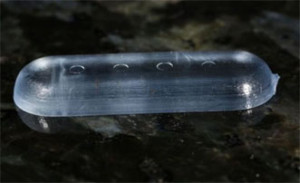 Sofmat Ltd. has developed a prototype device for creating the bar codes for microscale identification has been developed by in collaboration with engineers from the University of Bradford and with funding from Innovate U.K., a government funding agency.
Sofmat Ltd. has developed a prototype device for creating the bar codes for microscale identification has been developed by in collaboration with engineers from the University of Bradford and with funding from Innovate U.K., a government funding agency.
Integrated into an injection molding system, the device is capable of generating more than 1.7 million bar code configurations on anything from cellphones to pills. The indentations are created by an array of pins that can be set at different heights using microactuators. Each 0.4-μm step corresponds to either a letter (A-Z) or a number (0-9).
“These have to be set with a very high accuracy, and with sufficient force so their position is maintained during the manufacturing process,” said Dr. Ben Whiteside, a senior lecturer at Bradford. “While our system has been developed initially for products made from plastics or composites through injection molding, it could also be used to stamp or emboss the code onto a product.”
The resulting marks are virtually invisible to the naked eye and impossible to detect by touch. The system has been verified in the laboratory using a white light interferometer and a laser-scanning confocal microscope to characterize the surface of the coded product and ensure the code is accurately reproduced.
“A 3D bar code allows much more complexity than existing anticounterfeit systems,” said Sofmat Director Dr. Phil Harrison. “You can have multiple configurations, different codes on each individual product and additional details such as patterns on the heads of the pins themselves, making copying the code extremely difficult.”
A laser scanner is in development that will be able to read the code and wirelessly transmit the result to mobile devices.
The patented technology is already generating interest from the electronics, automotive and pharmaceutical sectors, where counterfeiting is a serious issue.


